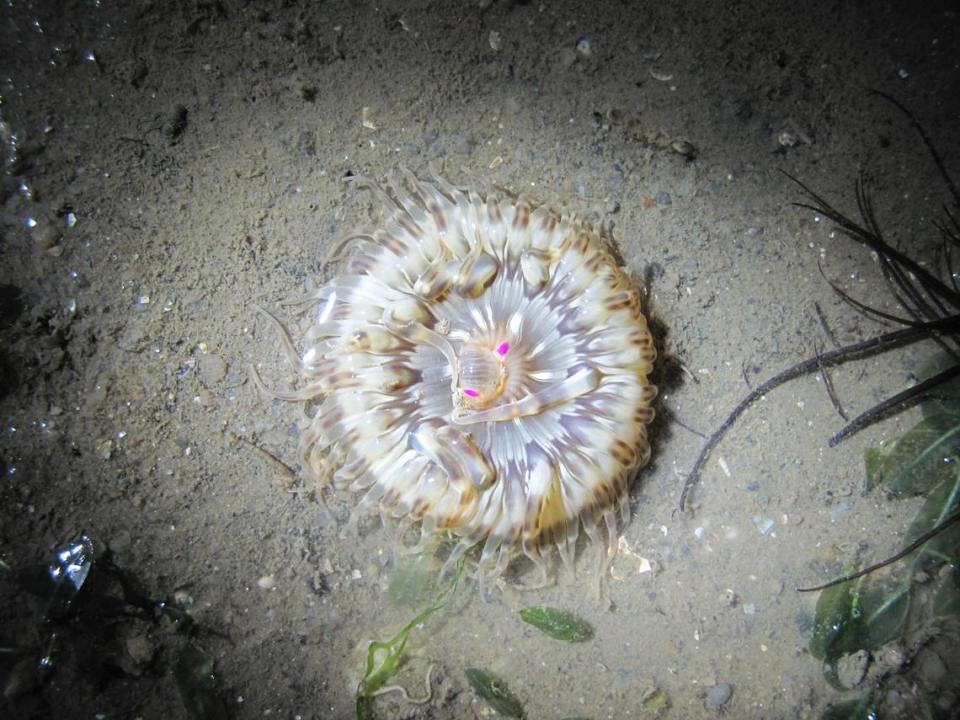Venomous sea creature with 96 arms can turn itself inside out. See the new species
Partially buried in the sand of a beach in Singapore, a venomous sea creature spread its 96 arms.
It was probably waiting for a meal to swim nearby. Instead, passing scientists spotted the multi-colored animal — and discovered a new species.
“The animal was first encountered by a team of local citizen scientists more than a decade ago,” researcher Nicholas Yap told McClatchy News in an email. They showed it to a scientist, Daphne Fautin, who suspected it was a new species.
Intrigued by the possibility, Yap and a team of researchers started investigating. They surveyed the northern coast of Singapore searching for sea anemones, according to a study published July 6 in the journal Zoological Studies.
At high tide, researchers found striped sea anemones with their tentacles spread out in the shallow water, the study said. At low tide, researchers found the exposed animals turned inside out by using their throats to hide the rest of their body.
Researchers studied the living sea anemones, collected 29 specimens and got to work trying to identify the animal, the study said.

“It’s such a chaotic group of animals and everything looks similar,” Yap told The Straits Times.
“It starts off with a great deal of uncertainty. Is it a new species? Is it not?” Yap said. “Eventually it metamorphosizes into a detective story where you have to track down all pieces of the evidence and clues to try to determine the identity of the new species.”
Scouring archives of known sea anemones and comparing them to the unidentified creatures, researchers realized they’d discovered a new species: Macrodactyla fautinae, or the tiger anemone.
The tiger anemone has a cylindrical body that can reach just over 3 inches across, the study said. It has 96 “smooth” tentacles with a striped brown-white pattern. The sea anemone’s central body is cream with pink wart-like bumps. These bumps can expel water, similar to “a watering can,” when the animal contracts.
The tiger anemone’s other distinctive behavior is its ability to turn its throat inside-out — a behavior that has baffled scientists, the study said.
“We do not know why it does that,” Yap said, “but we hypothesize it is used to catch prey.”
The anemone has stinging structures along its throat that are exposed when it turns inside out, the study said.
A photo shared by co-author Ria Tan on Facebook shows a tiger anemone sitting this way.
Thanks to Dr Nicholas Yap, who described this sea anemone as a new species Macrodactyla fautinae. So far, it has only...
Posted by Ria Tan on Wednesday, July 12, 2023
The tiger anemone can catch much larger prey and eat it whole, the study said. Another photo shared by Tan shows one such catch. Yap identified the prey as a sea pen.
Like other cnidarians, an animal group which includes jellyfish, sea anemones are venomous and can sting. Sea anemone stings hurt worse when the species has battery-like stingers, Yap said. The tiger anemone lacks these “batteries” so its sting “may not hurt that much” but “we know so little about this anemone, we are uncertain if it is harmful to humans.”
Tiger anemones are “solitary” creatures, often living in sandy or silty areas, the study said. The new species has only been found along the northern coast of Singapore.
Macrodactyla fautinae, a new sea #anemone species from #Singapore to honour the late Prof Daphne Fautin @kunhm. By @lkcnhm @nustmsi @NUS_DBS @MTQ_Townsville https://t.co/2pot0JyMTA pic.twitter.com/H8XDANsFnV
— Reef Ecology Lab (@NUSReef) July 11, 2023
The new species’ scientific name, “fautinae,” was chosen in honor of Daphne Fautin, the scientist who first suspected it was an unknown sea anemone, researchers said.
“Throughout her career, (Fautin) had worked tirelessly to advance the knowledge of sea anemones,” researchers said.
The animal’s common name, the tiger anemone, refers to “its stripey tentacles” and hunting skills, Yap said. Singaporean locals referred to the animal as a “tiger anemone” and “purple-lip sand anemone” before it was scientifically discovered, according to the study.
The new species was identified as distinct based on its body shape, size, coloring, behavior and DNA, the study said
The research team included Nicholas Wei Liang Yap, Michela Lee Mitchell, Zheng Bin Randolph Quek, Ria Tan, Koh Siang Tan and Danwei Huang.
Elusive sea creature — that ‘walks’ on its ‘hands’ — seen for first time in 27 years
‘Docile’ creature — with ‘triangular’ head — found eating frogs. It’s a new species
Furry creature likely lived undetected for millions of years — until now, study says

